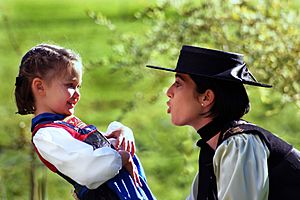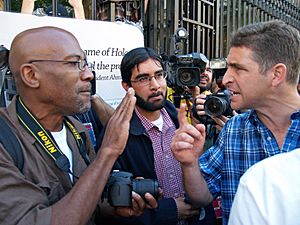Eye contact facts for kids
Eye contact happens when two people look directly into each other's eyes at the same time. It is a way we communicate without using words. This is called nonverbal communication.
Eye contact is a very important part of how we talk to each other. What it means can change a lot depending on the situation. The rules and meanings of eye contact are different in many cultures around the world. Even religious and social beliefs can change its meaning.
When people make eye contact, they often share feelings and social information. We might not even realize it, but we often look at someone's eyes and face for clues. These clues can tell us if they are happy, sad, or feeling something else. Sometimes, looking into someone's eyes can create strong feelings.
Eye contact can also be important when people are showing interest in each other. It can help them see if the other person feels the same way.
Eye Contact Around the World
Eye contact means different things in different places. What is polite in one country might be rude in another.
Cultural Differences in Eye Contact
In some cultures, especially in the past, the roles of women and men were very different. Women were often expected to lower their eyes. They would not look directly at a man's face as a sign of respect. Also, looking at others in an inappropriate way is often not allowed.
Another difference is how people show respect to someone with higher social status. For example, in Japan, children learn to look at their teacher's neck or tie knot. They do not look directly into their teacher's eyes. As adults, Japanese people often lower their eyes when talking to a boss or elder. This shows their respect.
In many cultures, like those in East Asia and Nigeria, it is a sign of respect not to look directly at a person in charge. However, in Western culture, avoiding eye contact can be seen as a sign of being untrustworthy. People might think you are "shifty-eyed" if you do not look at them.
Images for kids
-
Two figures making eye contact in Caravaggio's The Fortune Teller
See also
 In Spanish: Contacto visual para niños
In Spanish: Contacto visual para niños







